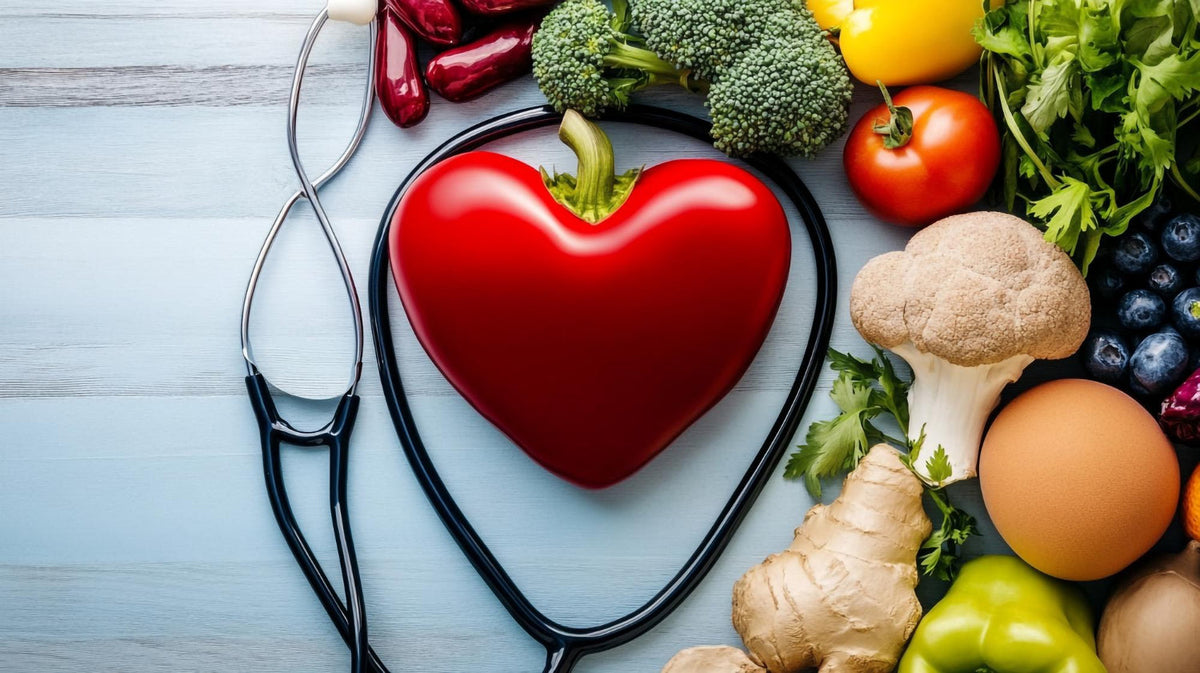How to Lower Cholesterol Naturally: Evidence-Based Lifestyle & Supplement Strategies

“Cholesterol” covers several moving parts: LDL and HDL particles that transport fats, and triglycerides that reflect circulating energy. High LDL—especially when particles are small and easily oxidised—raises cardiovascular risk, but focusing on a single number misses the bigger picture. What moves risk in the right direction is a combination of nutrition, activity, weight management, and targeted supplements that address the mechanisms behind dyslipidaemia: insulin resistance, chronic inflammation, and hepatic overproduction of lipoproteins.
This practical guide prioritises interventions with repeatable evidence: soluble fibres (psyllium, oat beta-glucans, guar gum), plant sterols, polyphenol-rich foods, and marine-derived omega-3s (DHA/EPA—including vegan algae sources). We also examine berberine for its AMPK effects, where it can support LDL and triglyceride improvements alongside diet and exercise. You’ll find a simple food-mechanism table, a training blueprint that increases LDL-receptor activity, plus ways to combine strategies without turning your kitchen into a clinical trial.
A quick safety note: natural does not equal risk-free. If you use prescription lipid-lowering medicines or have cardiovascular, liver, thyroid, or kidney conditions, discuss changes with your GP. Some supplements interact with medications, and “stacking” too many strategies at once makes it hard to see what actually helps.
Cholesterol 101: What the Numbers Really Mean

Cholesterol transport in the body functions much like a courier system. Low-density lipoproteins (LDL) carry cholesterol outward from the liver to tissues that need it for cell membranes, hormones, and bile acid production. High-density lipoproteins (HDL) act as the return fleet, retrieving excess cholesterol and sending it back to the liver for recycling or excretion. The system falters when LDL particle numbers climb too high or when those particles become oxidised — a change that makes them more likely to lodge in arterial walls and trigger inflammation. Triglycerides, meanwhile, reflect the amount of circulating energy. When calorie intake exceeds demand, the liver converts that surplus into very-low-density lipoproteins (VLDL), which later transform into LDL. Persistently high triglycerides often signal hepatic overproduction of these lipoproteins and underlying insulin resistance.
Improving this “traffic flow” depends on creating conditions that (1) reduce hepatic VLDL output, (2) enhance LDL-receptor activity so more LDL is cleared from the blood, and (3) shield lipids from oxidative stress. Four mechanisms stand out.
Soluble fibre—found in oats, psyllium, barley, and kiwi—binds bile acids and cholesterol in the gut, forcing the liver to pull more LDL from circulation to make new bile. Plant sterols and stanols resemble cholesterol closely enough to compete for intestinal absorption, lowering LDL without affecting HDL. Omega-3 fatty acids from fish oil or marine algae reduce hepatic triglyceride synthesis and can modestly improve HDL function. Finally, regular exercise enhances insulin sensitivity and up-regulates hepatic LDL receptors, allowing more cholesterol to be cleared from the bloodstream while reducing the production of triglyceride-rich particles.
Together, these dietary and lifestyle adjustments improve lipid balance at its root—within the liver’s metabolic engine—rather than merely chasing a single blood-test number.
Food First: Dietary Patterns That Consistently Lower LDL
Start with daily soluble fibre (7–10 g), swap part of saturated fat for extra-virgin olive oil and nuts, and target two serves of oily fish or algae-based omega-3 weekly. Add plant sterols (via fortified foods) and emphasise polyphenol-rich produce (berries, green tea, pomegranate). Keep refined carbs and trans fats low to reduce triglycerides and oxidation.
| Food / Add-on | Key Mechanism | Typical Impact |
|---|---|---|
| Psyllium / Oat beta-glucan Soluble fibre | Binds bile acids → increased LDL clearance | ~5–10% LDL reduction when used daily |
| Plant sterols (fortified) Absorption block | Compete with cholesterol in gut | ~7–15% LDL reduction at ~2 g/day |
| Algae/fish omega-3 Omega-3 | Less hepatic triglyceride output | 15–30% ↓ triglycerides; supports HDL function |
| Extra-virgin olive oil, nuts Polyphenols | Anti-inflammatory, oxidation protection | Improved HDL function; modest LDL benefits |
| Guar gum / Kiwi / Barley Fibre | Viscous fibre increases excretion | Additional ~5% LDL reduction |
Training That Changes Your Lipids
The aim is to increase LDL-receptor activity and insulin sensitivity while reducing hepatic fat. A simple, sustainable split works best: three brisk cardio sessions (20–30 minutes) plus two short resistance workouts each week. Cardio—whether fast walking, cycling, or swimming—improves the enzymes that help clear triglyceride-rich particles and raises HDL function. Resistance training preserves lean mass, which keeps resting metabolic rate higher during weight loss and further improves insulin signalling.
For those new to training, accumulate movement in ten-minute bites and add a few “movement snacks” after meals (a 10-minute walk can meaningfully blunt the post-prandial triglyceride and glucose rise). Prioritise sleep (7–8 hours), moderate alcohol, and don’t smoke. Small weekly weight loss (0.25–0.5 kg) produces measurable lipid improvements; dramatic swings are unnecessary and hard to maintain. Track progress via fasting lipids, waist measurement, and how you feel during activity rather than chasing daily scale noise.
Natural Compounds With Solid Evidence
Berberine. This plant alkaloid activates AMPK, a master metabolic switch that improves insulin sensitivity and can reduce hepatic lipoprotein production. Studies report meaningful LDL and triglyceride reductions alongside diet and exercise. It pairs well with a fibre-first approach and is often most useful when blood glucose runs high or metabolic syndrome is present.
Plant sterols. At ~2 g/day from fortified foods, sterols/stanols consistently reduce LDL by ~7–15% without lowering HDL. They’re mechanism-specific (gut absorption), so they stack cleanly with fibre and exercise. People with rare sitosterolaemia should avoid them.
Omega-3 DHA/EPA (including vegan algae sources). Best for high triglycerides and for general cardiometabolic support. Typical effects are 15–30% triglyceride reduction; LDL may be unchanged or slightly higher in some contexts, but overall risk markers often improve, especially when dietary quality rises.
Red yeast rice (RYR). Contains monacolin K, chemically identical to lovastatin. While effective for LDL lowering, product potency varies and statin-like side effects/interactions apply. Use only under medical guidance. If you already take a statin, do not add RYR.
Product Spotlights: Natural Cholesterol & Triglyceride Support

Therapeia Australia — Omega 3 Marine Algae 60 Capsules
- Plant-based source—ideal if you don’t eat fish.
- Supports triglyceride management and HDL function.
- Pairs well with fibre-first diet changes.

Melrose Futurelab — Berberine Complex 30 Capsules
- Complements fibre, plant sterols, and exercise.
- Particularly useful in insulin-resistant profiles.
- Review medications for interactions before use.

Blackmores Insolar Vitamin B3 — 60 Tablets
- Included to clarify the B3 forms and avoid confusion.
- Not a cholesterol treatment; consult your GP for niacin.
- Best used for its intended skin-health applications.
Your 8-Week Natural Cholesterol Plan
Weeks 1–2: establish daily viscous fibre (psyllium or guar gum) and swap part of saturated fat for extra-virgin olive oil and nuts. Add two 10-minute post-meal walks most days. If triglycerides are high, start algae or fish-derived omega-3s. Track breakfasts and add oats or barley at least four mornings a week.
Weeks 3–4: introduce plant sterols from fortified foods, and move to a steady training split—three cardio sessions plus two short resistance workouts weekly. If fasting glucose trends high or you have central adiposity, discuss berberine with your GP and begin at a conservative dose. Prioritise 7–8 hours’ sleep; alcohol to low-moderate.
Weeks 5–8: keep the rhythm, adjust portions for gradual weight loss if needed, and retest lipids. Most people see the clearest triglyceride improvements first, followed by LDL changes as fibre/sterols and training accumulate. Continue whatever drove objective improvements and prune anything you’re not tolerating. Sustainable beats perfect.
Frequently Asked Questions
What reduces cholesterol quickly?
Daily viscous fibre (psyllium/oats), removing trans fats, adding omega-3s, and short post-meal walks. Expect lab changes over weeks, not days.
What are the worst foods for high cholesterol?
Ultra-processed foods, fried items, pastries, and foods with trans fats or excess refined carbs. Prioritise whole foods, olive oil, legumes, nuts.
What reduces cholesterol in 7 days?
You can start behaviours—fibre, olive oil swaps, movement—but meaningful lipid shifts typically appear after 8–12 weeks of consistency.
What is a good breakfast for high cholesterol?
Oats or barley with berries and nuts; Greek yoghurt with chia/psyllium; whole-grain toast with avocado and extra-virgin olive oil.
Is coffee bad for cholesterol?
Unfiltered coffee can raise LDL (cafestol). Paper-filtered coffee reduces this effect. Keep sugar and cream modest.
Do bananas lower cholesterol?
Helpful for fibre and potassium, but meaningful LDL reductions come from viscous fibres like psyllium, oats, and guar gum.
Does lemon water lower cholesterol?
No direct effect. It’s fine as a low-calorie drink; lipid improvements come from overall diet quality, fibre, and activity.
What is the best drink to lower cholesterol naturally?
There’s no miracle drink. Unsweetened green tea offers polyphenols; the biggest wins come from fibre-rich meals and exercise.
What is the best vitamin to take to lower cholesterol?
No single vitamin fixes cholesterol. Evidence supports plant sterols, viscous fibre, omega-3s; niacin requires GP supervision.
Do eggs raise cholesterol?
For most, dietary cholesterol has limited impact versus overall pattern. People with familial hypercholesterolaemia should follow medical advice.
About this article
- Plant Sterols and Plant Stanols in Cholesterol Management and Cardiovascular Prevention — Nutrients (MDPI) (Jun 2023)
- The clinical relevance of omega-3 fatty acids in the management of hypertriglyceridemia — Lipids in Health and Disease (BioMed Central) (Jan 2016)
- Triglyceride-lowering and anti-inflammatory mechanisms of omega-3 polyunsaturated fatty acids for atherosclerotic cardiovascular risk reduction — Journal of Lipid Research (Jul 2001)
-
14 October 2025Notes:Article published


